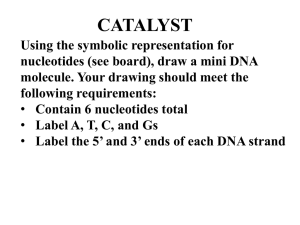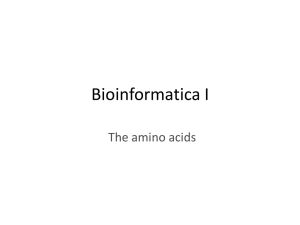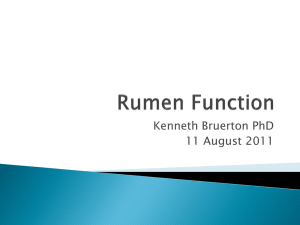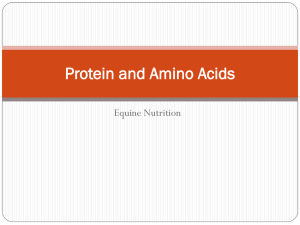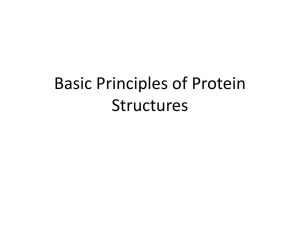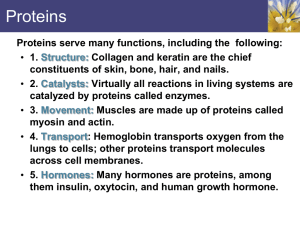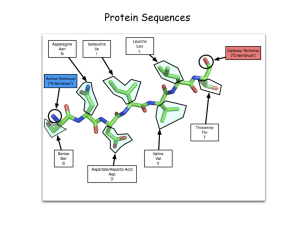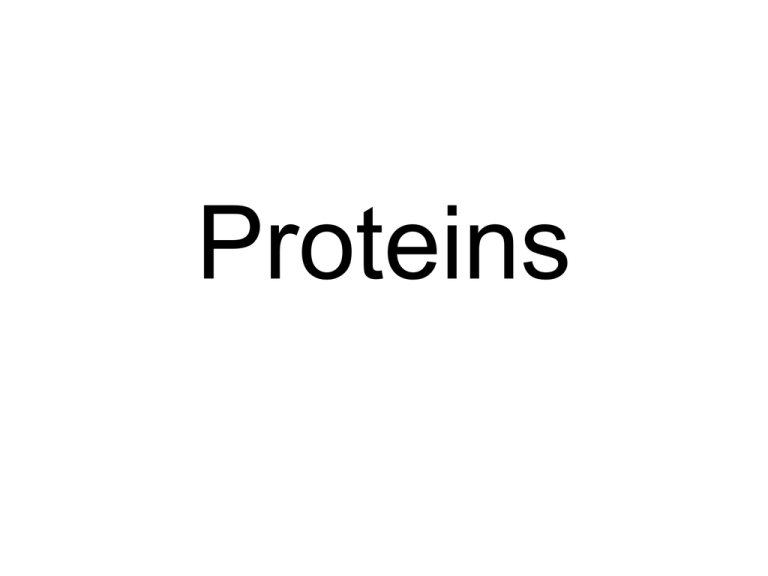
Proteins
Building Blocks of Protein: Amino Acids
• All protein is composed of Amino Acids
• Amino Acids are Nitrogen bearing
compounds that form the structural units of
protein
• Amino means nitrogen containing
• Proteins have carbon, hydrogen, oxygen,
and 16% nitrogen
• Each Amino Acid is joined by a peptide bond
– Two amino acids are called a dipeptide
– Polypeptides are chains of up to 100
amino acids
Amino Acids
• When protein foods are eaten, proteins
are broken down into amino acids
• Amino acids are reassembled in the body
to form a variety of proteins
• The body requires 20 different amino
acids which are classified as:
– Indispensable
– Dispensable
– Conditionally Indispensable
Classes of Amino Acids (Page 47 table 4-1)
• Indispensable Amino Acids (Essential)
– Nine amino acids the body cannot manufacture in
sufficient quantity
– Vital to life and health
• Dispensable Amino Acids (Non-Essential)
– Five amino acids that the body can synthesize from
other amino acids
• Conditionally Indispensable Amino Acids (NonEssential)
– Six amino acids that are normally synthesized in the
body by other amino acids
– Under stress and illness these amino acids must be
consumed in the diet
Functions of Protein
• Structural Tissue Building
• Protein Balance
• Source of Energy
• Water and pH Balance
• Digestion
• Transportation
• Hormones
• Blood Plasma (hemoglobin)
• Body Defense System
Tissue Building
• Fundamental structural material of every cell
• Comprises bulk of:
– Muscles (actin, myosin, troponin,
tropomyosin), internal organs, brain,
nerves, blood plasma (myoglobin,
hemoglobin), skin, hair, nails, hormones,
and enzymes
• Protein repairs worn-out, wasted, or
damaged tissue (burns, cuts, and scrapes;
muscle tears after exercise)
Protein Balance
• Nitrogen balance indicates how well the
body’s tissues are being maintained; it is
achieved in healthy adults.
• Protein balance
–Catabolism: Breakdown
–Anabolism: Resynthesis (build-up)
• To maintain balance, nitrogen is
converted to ammonia and excreted
as urea in urine (deamination)
Protein Balance
• Nitrogen balance (intake = excretion)
– Positive Nitrogen balance: body stores more
than it excretes
• Pregnancy, Infancy, Childhood, Adolescence
– Negative Nitrogen balance: body takes in less
than it excretes
• Illness and Malnutrition
• During a period of negative nitrogen balance the
person is not getting enough protein in the diet and
the body is breaking down tissue to provide energy
or other critical functions
• Kwashiorkor: Protein deficiency disease
Source of Energy
• Provides 4kcal/gram
• May provide body fuel if the supply
of carbohydrate and fat is
insufficient for needs
• Less efficient
Water and pH Balance
• pH (potential of Hydrogen) is a measure of the
acidity or alkalinity of a solution
• The value of pH can be between 0 and 14. The
intermediate value is 7 (water); values lower than
7 indicate acidic and values higher than 7
indicate alkaline condition (soft drinks have a pH
of 2.5)
• pH level of our bodies should be between 7.2
and 7.6 (blood is between 7.35 and 7.45)
• Proteins act as buffering agents (adjusts the pH
of a solution) by releasing or taking up excess
acid within the body
Digestion, Transportation, and Hormones
• Enzymes are proteins necessary for
digestion
• Proteases are enzyme proteins
• Transport agents
– Lipoproteins (HDL’s and LDL’s)
– Hemoglobin (oxygen carrier in red blood
cells)
• Protein Hormones
– Insulin and Glucagon
Body Defense System
• Proteins help build lymphocytes which
are white blood cells
–Defend the body against infection
• Antibodies also called
immunoglobulins which are large yshaped proteins which function to
identify and help remove foreign
antigens such as viruses and bacteria
Food Sources of Protein
• Complete Proteins:
– All 9 indispensable proteins in the quantity and
correct ratio to maintain nitrogen balance and allow
for tissue growth and repair
– Primarily of animal origin (egg, milk, meat, cheese,
poultry, seafood)
– Soy products are the only plant sources of
complete protein
• Incomplete Proteins:
– Deficient in one or more indispensable amino acids
– Grains, legumes, nuts, seeds, fruits, vegetables
Whey Protein
• It is the liquid that is left behind after the first
stages of cheese-making
• It looks like curdled milk
• The whey is the liquid component that separates
from the solid particles. ("Curds and whey" is,
essentially, cottage cheese.)
• High in protein and found in dairy products, protein
shakes, bars, and many processed foods
• Also known as whey protein isolates, whey protein
concentrate, whey protein hydolysate, and
hydrolized protein
Is Whey Protein Good For You?
• Whey protein supplements are just that,
Supplements.
• They should never be used to replace protein
obtained from a healthy daily diet.
• Whey protein may cause allergic reactions in people
who suffer from lactose intolerance or who are
generally allergic to dairy products.
• Whey proteins may be easier to
digest
Soy
• Research suggests that daily intake of soy protein
may slightly lower levels of LDL cholesterol. However,
the results have been inconsistent.
• There is not enough scientific evidence to determine
whether soy supplements are effective for any other
health uses
• Soy is considered safe for most people when used as
a food
• Minor stomach and bowel problems such as nausea,
bloating, and constipation are possible
• Allergic reactions such as breathing problems and
rash can occur in rare cases
Soy
• Soy's role in breast cancer is
uncertain. Until more is known
about soy's effect on estrogen
levels, women who have or who
are at increased risk of developing
breast cancer or other hormonesensitive conditions (such as
ovarian or uterine cancer) should
be careful about using soy and
should discuss it with their doctors
Vegetarian Diets
• Lacto-ovo vegetarian: Dairy products and
eggs, excluding meat and fish, to
complement diet of plant foods
• Lacto-vegetarian: Milk and milk products to
complement diet of plant foods
• Ovo-vegetarian: Eggs are only animal foods
to complement diet of plant foods
• Vegan: No animal foods, diet of plant foods
only
Health Benefits of Vegetarian Diets
• Lower levels of saturated fat and cholesterol
• Lower rates of death from cardiovascular
disease (hypertension)
• Lower risk of type 2 diabetes and some forms
of cancer (colon and prostate)
• Lower risk of dementia
• Lower risk of kidney disease
• Lower body mass index and prevalence of
obesity
• Higher levels of antioxidants
Vegetarian Diets
• Must combine foods to cover all amino acid needs
• Grains and peas, beans, or lentils; legumes and
seeds; grains and dairy
– Brown rice and beans
– Whole grain bread with pea or lentil soup
– Wheat or corn tortilla with beans
– Peanut butter on whole wheat bread
– Falafel (chickpeas) on whole wheat pita bread
– Hummus on whole wheat pita bread
– Whole wheat pasta tossed with peas, almonds, or
cheese
– Garden burger on a whole wheat bun
Vegetarian/Vegan Tips to Meet Protein
Requirements
• Add beans, seeds, or nuts to salads
• Eat pecans, almonds, walnuts, cashews and peanut
butter for protein
• Make smoothies with soy milk or hemp milk
• Choose soy nuts over potato chips for a high-protein
snack
• Substitute quinoa for rice or pasta
• Sprinkle nuts and seeds on cereal
• Crumple firm tofu into pasta sauces
• Add beans to soups
• Make your own trail mix and include soynuts and
almonds
Digestion of Proteins
• Mouth:
– Mastication (chewing) mixed with saliva to
form a bolus; a semisolid food mass
• Stomach:
– Chemical digestion of protein begins in the
stomach
– Hydrochloric acid changes pepsinogen into
pepsin
– Pepsin is the main gastric enzyme of the
stomach. It changes large amino acids into
peptides
Digestion of Proteins
• Small Intestine:
– Protein digestion is completed here by enzymes
from pancreas and intestine
• Pancreas:
– Trypsin, Chymotrypsin, and Carboxypeptidase
breaks up polypeptides into dipeptides
• Intestines:
– Aminopeptidase and Dipeptidase breaks up
dipeptides into amino acids
• The free amino acids are ready to be absorbed
into blood circulation
Body Needs for Protein
• Tissue growth
• Dietary protein quality
–Chemical score (CS)
–Biologic value (BV)
–Net protein utilization (NPU)
–Protein efficiency ratio (PER)
Body Needs for Protein
• Tissue Growth:
– During rapid growth periods, more protein per
unit of body size is necessary to build new
tissue.
• Chemical score:
– Value derived from the amino acid pattern of the
food (an egg has a value of 100).
• Biologic value is based on nitrogen balance
• Net protein utilization is based on biologic value
and the degree of digestibility.
• Protein efficiency ratio is based on weight gain
relative to protein intake
• Table 4-2 page 57 compares protein food scores
Dietary Deficiency or Excess
• Protein Energy Malnutrition (PEM)
– Kwashiorkor: Acute deficiency of protein.
Characteristics are edema and bloated
abdomen from lack of protein in blood to
maintain fluid balance (figure 4-6 page 57)
– Marasmus: Chronic deficiency of protein
(elderly and individuals with eating disorders)
• Excess protein
– Usually also means excess fat intake
– Protein displaces other healthy foods in diet
– Extra burden on kidneys
High Protein Diets
• Generally higher in total fat, saturated fat,
and cholesterol
• Initial weight loss is caused by ketosis and
fluid loss from a lack of carbohydrates
• Extra work for the kidneys and liver to
remove excess acids (deamination)
• Loss of muscle tissue from a lack of
carbohydrates
• Risk of deficiency diseases
Dietary Guidelines?
• Recommended Dietary Allowances
(RDAs)
– Relate to age, sex, weight
– Highest at birth and slowly decline into
adulthood
– Men and women: 0.8 to 2.0 g/kg of desirable
weight
• Dietary Reference Intakes (DRIs) from
National Academy of Sciences
– 10% to 35% of total caloric intake from
protein (children and adults)
Calculating Intake For Protein
• Calculate the protein needs of an
individual consuming 2800 kcal/day based
on the recommendations of 10% to 35%
of total calories
• Calculate the protein needs of a woman
who is 5 feet six inches tall and weighs
150 pounds based on the
recommendations of .8 to 2.0 g/kg per day
Nutrition Assignment
• Refer to page 61 in your
nutrition book and answer
Critical Thinking Questions 2
and 3





